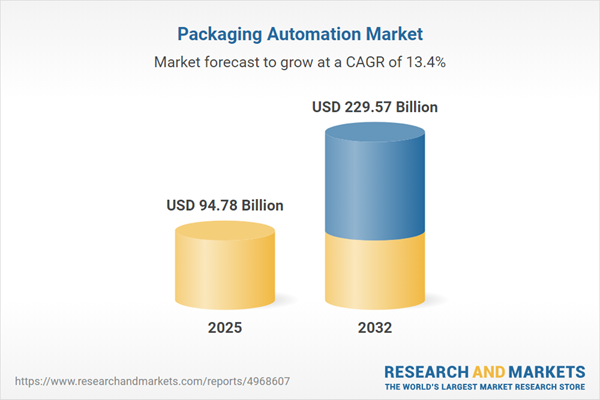Speak directly to the analyst to clarify any post sales queries you may have.
The packaging automation market is evolving at pace, addressing the critical needs for precision, speed, and adaptability across manufacturing and supply chains. As automation technologies become integral to packaging strategies, leaders are redefining processes to meet shifting regulatory demands and consumer expectations.
Market Snapshot: Packaging Automation Market Size and Growth Trajectory
The packaging automation market grew from USD 83.72 billion in 2024 to USD 94.78 billion in 2025. It is projected to continue expanding at a CAGR of 13.43%, reaching USD 229.57 billion by 2032. Sector growth is being propelled by the combined effects of technological advancements, rising customization demand, and evolving regulatory landscapes across global value chains.
Scope & Segmentation
- Automation Types: Fully automated systems; semi-automatic solutions offering flexible, incremental automation pathways.
- Machine Types: Case packers; conveyors (belt, chain, roller variants); fillers (liquid, paste, powder); labelers (pressure sensitive, sleeve, wrap-around); palletizers; wrappers.
- Packaging Types: Bags and pouches (side gusset, spout, stand up); bottles; cartons; cases; sachets; trays; wraps.
- End Use Industries: Automotive & electronics (OEM assemblies, consumer devices); e-commerce & logistics (order fulfillment, returns processing); food & beverage (beverages, dairy, packaged foods); healthcare & pharmaceuticals (biotech, medical devices, pharmaceuticals); personal care & cosmetics (cosmetics, toiletries).
- Regions Covered: Americas (North America, Latin America); Europe, Middle East & Africa (UK, Germany, France, Russia, Italy, Spain, Netherlands, Sweden, Poland, Switzerland, UAE, Saudi Arabia, Qatar, Turkey, Israel, South Africa, Nigeria, Egypt, Kenya); Asia-Pacific (China, India, Japan, Australia, South Korea, Indonesia, Thailand, Malaysia, Singapore, Taiwan).
- Key Companies Profiled: Tetra Pak International S.A.; Krones AG; Barry-Wehmiller Inc.; Coesia S.p.A.; ProMach, Inc.; KHS GmbH; Syntegon Technology GmbH; IMA S.p.A.; MULTIVAC Sepp Haggenmüller SE & Co. KG; Marchesini Group S.p.A.
Key Takeaways for Decision-Makers
- Advanced robotics, machine vision, and intelligent control systems are reshaping manufacturing flows, resulting in greater flexibility and enabling quick changeovers aligned with complex production requirements.
- Integration of operational technology and information platforms drives real-time analytics, supporting the optimization of workflows and continuous process improvement initiatives.
- Sustainability and regulatory demands are influencing equipment design choices, as firms seek to address traceability, material reduction, and compliance with serialization in sectors like pharmaceuticals and food.
- The adoption of collaborative robotics and digital twin technologies allows for the simulation, optimization, and validation of packaging lines before capital investments are made, reducing implementation risks.
- Vendor partnerships, open architecture software, and modular hardware investments are helping enterprises build scalable and future-ready packaging ecosystems for diverse markets.
Tariff Impact in 2025
The 2025 introduction of new United States tariffs on imported automation components has altered global supply chains and cost structures in packaging automation. Companies are mitigating these effects through strategic sourcing, diversification of supplier networks, and increased nearshoring within tariff-exempt regions. These shifts require careful cost-benefit evaluation and contribute to an accelerated move toward advanced automation, which not only offsets labor dependencies but also shortens payback cycles amid new cost pressures.
Methodology & Data Sources
This analysis leverages structured interviews with engineers, plant managers, and executive stakeholders, complemented by secondary research from industry publications, patent filings, and regulatory documents. Subject matter experts validated findings to ensure actionable recommendations reflect current operational realities and trends.
Why This Report Matters
- Helps senior leaders align automation investments with operational and regulatory priorities in a changing global context.
- Supports strategic planning by providing actionable segmentation insights and region-specific adoption dynamics relevant to business expansion strategies.
- Offers a robust, evidence-based assessment to guide technology upgrades, supplier negotiations, and risk management efforts.
Conclusion
As packaging automation advances, integrating flexible technologies, data-driven approaches, and regulatory foresight will be crucial for sustained market competitiveness. This report enables informed decisions that balance innovation with operational efficiency and compliance.
Additional Product Information:
- Purchase of this report includes 1 year online access with quarterly updates.
- This report can be updated on request. Please contact our Customer Experience team using the Ask a Question widget on our website.
Table of Contents
3. Executive Summary
4. Market Overview
7. Cumulative Impact of Artificial Intelligence 2025
Companies Mentioned
The companies profiled in this Packaging Automation market report include:- Tetra Pak International S.A.
- Krones AG
- Barry-Wehmiller Inc.
- Coesia S.p.A.
- ProMach, Inc.
- KHS GmbH
- Syntegon Technology GmbH
- IMA S.p.A.
- MULTIVAC Sepp Haggenmüller SE & Co. KG
- Marchesini Group S.p.A.
Table Information
| Report Attribute | Details |
|---|---|
| No. of Pages | 183 |
| Published | October 2025 |
| Forecast Period | 2025 - 2032 |
| Estimated Market Value ( USD | $ 94.78 Billion |
| Forecasted Market Value ( USD | $ 229.57 Billion |
| Compound Annual Growth Rate | 13.4% |
| Regions Covered | Global |
| No. of Companies Mentioned | 11 |









